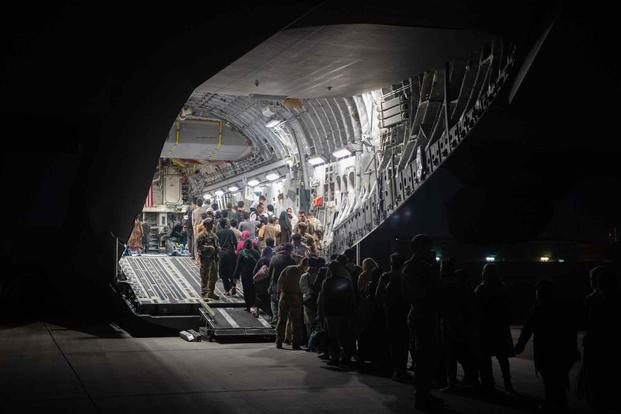After the intense, weeks-long effort to evacuate tens thousands of civilians from the Kabul airport in the wake of Afghanistan's fall to Taliban forces, Air Mobility Command, or AMC, now is focusing on how to help its airmen heal.
The 17-day airlift was the largest such noncombatant evacuation operation in the U.S. military's history, helping get more than 124,000 Americans, Afghans and other foreign nationals out of Afghanistan.
But it also pushed airmen and aircraft to their limits. And in a roundtable discussion with reporters at the Air Force Association's Air Space Cyber conference in National Harbor, Maryland, on Monday, AMC officials said they now need to recover.
Read Next: Navy Secretary Says All COVID-19 Sailor and Marine Deaths During His Tenure Have Been Unvaccinated
"These are significant traumatic events for these folks that are there," Col. Colin McClaskey, who served as a contingency response commander -- in charge of setting up or restoring airfield operations in a disaster area or hostile zone -- at Hamid Karzai International Airport in Kabul during the evacuation, said of the people airmen save during emergencies such as Afghanistan, Hurricane Katrina or Haiti. "Lives are truly impacted -- unfortunately, in some cases, destroyed. Our airmen and all our partners that were there, they see that. It's very personal for them."
The scale of C-17 Globemaster III operations in the latter half of August was immense. On a typical day, said Brig. Gen. Dan DeVoe, commander of the 618th Air Operations Center, the Air Force usually has about 60 C-17s operating around the world out of its fleet of roughly 222. But during the evacuation, there were usually about 60 C-17s flying in just Europe and the Middle East area. And at its peak, there were an average of 113 C-17s flying per day.
The Aug. 16 incident in which many panicked Afghans breached the airfield in two locations and rushed toward a C-17 in the process of taking off -- perhaps the most traumatic event of the evacuation -- is still under investigation. Afghans tried to climb aboard that taxiing C-17, and some fell to their deaths or were found crushed in the aircraft's wheel well.
The Air Force and FBI are working together on the investigation, which is expected to be finished in the next month or two, AMC Commander Gen. Jacqueline Van Ovost said.
She explained that the most important thing for the Air Force was to make sure that C-17's crew was OK and had the support services necessary to process what had happened. After an unspecified period of time, she said, that crew was able to get back into action and continue conducting evacuations.
"I cannot stress how dynamic that situation was on the ground," Van Ovost said. "If something different had happened, the entire [evacuation operation] could have been in jeopardy. ... That airfield was everything for that operation."
McClaskey said that before his 89 airmen who helped run air traffic control, aircraft loading and other operations at the Kabul airport even started to head home, the wing leadership at Joint Base McGuire-Dix-Lakehurst in New Jersey pledged to support them.
"We know everybody's going through a lot," McClaskey said his wing commander told him. "We're gonna set up things to take care of you guys."
When the team got back to Germany, they spent three days debriefing at Ramstein Air Base. And once they returned to the United States, the Task Force True North program from Travis Air Force Base in California helped provide chaplains, mental health providers and other such workers. McClaskey said many airmen have taken advantage of the True North initiative -- a mental health program that seeks to embed social workers and mental health providers in units where they can interact with troops on a daily basis -- to help them process what happened.
Col. Adrienne Williams, commander of the 521st Air Mobility Operations Wing at Ramstein, said there were airmen from religious support teams and welfare offices who came out to support units and check on them.
"She was on the line with them, and basically looking in their eyes, making sure that they were OK," Williams said of one such support person. "They were, and they knew what impact they were making."
And the aircraft that did most of the heavy lifting during the Afghan airlift also need to recover, Van Ovost said.
For now, AMC is leaning more heavily on C-5 Galaxy aircraft and contract carriers to move cargo and personnel while the C-17s have deeper maintenance done and the crews rest.
Airmen also will need to get in training they had to postpone while they spent weeks focusing on the Afghan airlift, Van Ovost said.
-- Stephen Losey can be reached at stephen.losey@military.com. Follow him on Twitter @StephenLosey.
Related: Undercount: Famous C-17 Flight Filled with More Afghan Evacuees Than First Thought, Setting Record












